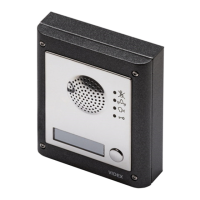ENUK - V1.4 - 25/01/17
42
4000 Series GSM Audio Intercom - Technical Manual
4000 Series GSM Audio Intercom with Proximity
Programming the GSM Intercom
STORE/QUERY A PROXIMITY FOB/CARD FOB, 000 999
Once the built-in proximity reader has been enabled and the number of bytes to check for has been set (refer to the EPR and PBY
setup on the previous page) the proximity fobs/cards can be programmed into the GSM PRO intercom.
The GSM PRO intercom can store up to 1000 fobs/card (000 - 999). The reader can be programmed with any one of the following
fobs:
• 955/T or 955/C = Videx fobs or cards. These fobs and cards have no site code and have a 5 digit user code, so
the PBY function must be set to 02 (the default setting, checking for 2 bytes).
• PBX1E or PBX2 = Portal Plus fobs or cards. These fobs and cards have a 3 digit site code and 5 digit user code,
so the PBY function can be set to 02 or 03.
The following texts can be used to program fobs or cards.
1111FOBnnn”site”,”user” Store fob/card in location nnn, where nnn = the memory location from 000 - 999 of where
the fob/card is actually stored (see examples below for each type of fob/card). The “site”
and “user” code is the number taken directly from the fob/card.
1111FOBnnn? Query the fob/card stored in memory location nnn and send a conrmation text back to
the sender with the stored fob/card details.
The following examples show how to program each fob/card type:
Example 1: Programming a 955/T or 955/C with no site code, a 5 digit user code of 12345 and storing it in memory location 001, the
following text can be sent to the GSM PRO intercom:
1111FOB001”0”,”12345”
(for these fob/card types a ‘0’ must be inserted for the “site” code).
Example 2: Programming a PBX1E or PBX2 with a 3 digit site code of 123, a 5 digit user code of 45678 and storing it in memory
location 010, the following text can be sent to the GSM PRO intercom:
1111FOB010”123”,”45678”
DISABLE OR ENABLE SPEECH BOARD SBM
The GSM PRO intercom includes call progress speech annunciation which can be disabled (01) or enabled (02). The default setting
for this function is enabled. The following text messages can be used to enable or disable this feature.
1111SBMnn Disable or enable speech board nn: 01 or 02 (01 = disabled, 02 = enabled).
1111SBMnn? Disable or enable speech board nn: 01 or 02 (01 = disabled, 02 = enabled), also send a
conrmation text back to the sender.
1111SBM? Query the speech board status.
SET SPEECH BOARD VOLUME SBV
The volume setting of the speech board in the GSM PRO intercom can be adjusted. The default volume level is set to 75, but can be
set anywhere between 00 (low) up to 99 (high). The following text messages can be used to increase or decrease the volume level
and query the current speech board volume setting stored.
1111SBVnn Increase or decrease speech board volume nn, where nn = 00 (low) - 99 (high).
1111SBVnn? Increase or decrease speech board volume nn, where nn = 00 (low) - 99 (high), also send
a conrmation text back to the sender.
1111SBV? Query the speech board volume setting.
FIND A TELEPHONE NUMBER FDT
The nd a telephone number feature allows the user to nd the dial to open location (between 000 - 999) of where a particular
telephone number is stored in the GSM PRO intercom. It can locate the number either from using the full telephone number or a
minimum of the last 4 digits of a number (see following examples). The following text messages can be used.
1111FDT”yyyyyyyyyyy”? Find dial to open location of telephone number yyyyyyyyyyy stored, where yyyyyyyyyyy
= telephone number (minimum of 4 digits).

